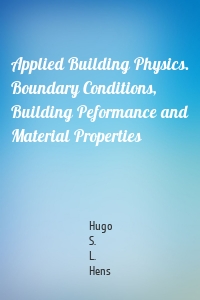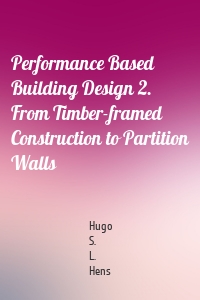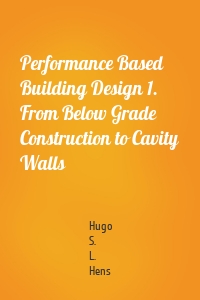Hugo S. L. Hens
6 кн.
Applied Building Physics. Boundary...
The energy crises of the 1970s, persisting moisture problems, complaints about sick buildings, thermal, visual and olfactory discomfort, and the move towards more sustainability in building construction have pushed Building Physics to the forefront of building innovation. The societal pressure to diminish energy consumption in buildings without impairing usability acted as a trigger to activate the whole notion of performance based design and construction. As with all engineering sciences,...
| Автор | Hugo S. L. Hens |
Building Physics - Heat, Air and Mo...
Bad experiences with construction quality, the energy crises of 1973 and 1979, complaints about 'sick buildings', thermal, acoustical, visual and olfactory discomfort, the need for good air quality, the move towards more sustainability, all have accelerated the development of a field, which until some 40 years ago was hardly more than an academic exercise: building physics. Building physics combines several knowledge domains such as heat and mass transfer, building acoustics, lighting, indoor...
| Автор | Hugo S. L. Hens |
Performance Based Building Design 2...
Just like building physics, performance based building design was hardly an issue before the energy crises of the 1970ies. With the need to upgrade energy efficiency, the interest in overall building performance grew. The term «performance» encompasses all building-related physical properties and qualities that are predictable during the design stage and controllable during and after construction. The term «predictable» demands calculation tools and physical models that allow evaluating a...
| Автор | Hugo S. L. Hens |
Performance Based Building Design 1...
Just like building physics, performance based building design was hardly an issue before the energy crises of the 1970s. With the need to upgrade energy efficiency, the interest in overall building performance grew. The term «performance» encompasses all building-related physical properties and qualities that are predictable during the design stage and controllable during and after construction. The term «predictable» demands calculation tools and physical models that allow evaluating a design,...
| Автор | Hugo S. L. Hens |
Applied Building Physics
Bad experiences with construction quality, the energy crises of 1973 and 1979,complaints about `sick buildings?, thermal, acoustical, visual and olfactory discomfort, the need for good air quality, the move towards more sustainability ? all these have accelerated the development of a field that, for a long time, was hardly more than an academic exercise: building physics. The discipline embraces domains such as heat and mass transfer, building acoustics, lighting, indoor environmental quality...
| Автор | Hugo S. L. Hens |
Building Physics -- Heat, Air and M...
Bad experiences with construction quality, the energy crises of 1973 and 1979, complaints about 'sick buildings', thermal, acoustical, visual and olfactory discomfort, the move towards more sustainability, have all accelerated the development of a field, which until 35 years ago was hardly more than an academic exercise: building physics. Through the application of existing physical knowledge and the combination with information coming from other disciplines, the field helps to understand the...
| Автор | Hugo S. L. Hens |







